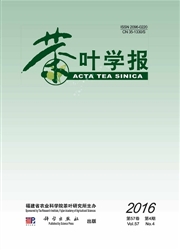

 中文摘要:
中文摘要:
测试分析不同适制乌龙茶品种(系)小至中开面的对夹二、三叶嫩梢茶叶铝含量,分析采摘时期对茶树新梢及茶汤铝含量的影响,阐明不同茶树品种及采摘时期对茶叶铝累积的影响并评价茶叶饮用安全。结果表明,福建省主栽适制乌龙茶品种(系)小至中开面的对夹二、三叶嫩梢茶叶铝含量在445.17-814.51mg·kg^-1之间,肉桂、黄玫瑰和紫玫瑰茶树品种茶叶铝含量较高,梅占、金牡丹和佛手茶叶铝含量较低。茶树新梢茶叶铝含量随着生长时间的延长迅速提高,采用指数方程可以很好模拟茶树新梢铝累积与生长时间的关系,控制茶叶采摘时期是控制茶叶铝含量的有效措施;随着新梢生长时间的延长,茶汤铝含量、茶叶铝溶出量及茶叶铝溶出率迅速升高,但日常饮用乌龙茶铝摄入量在安全限量范围内,不会对人体造成伤害。
 英文摘要:
英文摘要:
Two or three young shoots and a bud from the branches on tea plants of 13 Camellia sinensis (L.) O. Kuntze cultivars were plucked in either the normal manner for oolong tea or during different time periods to study the variation on aluminum (A1) content in the resulting teas for safety evaluation. The results showed that the Al concentrations ranged from 445.17 mg · kg^-1 to 814.51 mg· kg^-1 in the tea leaves picked by the standard method, and they were higher on Rougui, Huangmeigui, and Zimeigui varieties, while lower on Meizhan, Jinmudan, and Foshou. In general, A1 in the young shoots increased exponentially with delayed plucking. Therefore, it appeared that by postponing the leaf-plucking time the A1 content in the teas could he altered in a certain degree. In other words, the steeped tea would contain less A1 with a timely plucking of the leaves. On the other hand, the general daily consumption of oolong tea does not exceed the safety intake limits, and should not post any harm to human health.
 同期刊论文项目
同期刊论文项目
 同项目期刊论文
同项目期刊论文
 期刊信息
期刊信息
